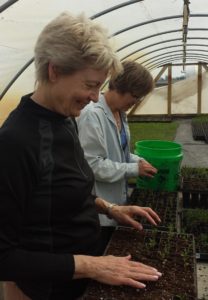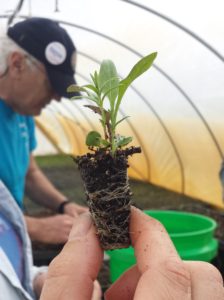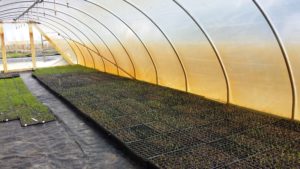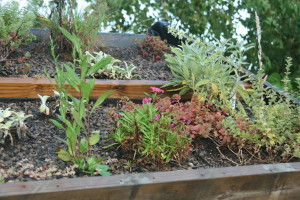It takes a village to help the Monarchs
/Sage Advice pleased to be able to offer help to an energetic committee in Park Ridge Illinois that is working to increase awareness of sustainability in our home suburb! One of the major projects of the committee this year is their Milkweed Project. The goal is to distribute 500 milkweed plants throughout the community this summer to help support Monarch butterflies. Committee members collected seeds last fall and this spring worked with Pizzo Native Plant Nursery who generously offered to stratify and germinate the seeds at their facility in Leland, Illinois. Plants will be ready in June for distribution throughout the community. Lurvey Landscape Supply in Des Plaines has offered to provide individual pots for seedings, and plants will be ready for distribution throughout the community in June. Committee members recently donated a day to help Pizzo Nursery transplant more than 8000 seedings into plug trays.
Daylilies always brighten the garden
/We had the rare privilege of visiting recently with daylily expert Ann Redmon from Manhattan Kansas. Ms. Redmon has cross-bred many daylilies to create new varieties, and has registered four of them. Pictured here is one of her registered lilies, called "Hannah Banana." Daylilies are great in any garden. But remember, you want cultivated varieties, not the common and very tall orange "ditch lilies" that spread by rhizomes and crowd out cultivated plants. Daylilies are easy to care for and add bright spots of midsummer color in shades of yellow, orange, red, white, pink, even green like this one, and combinations of these colors.
Sage Advice teaches Landscape for Life™ Classes
/Carol Becker, owner at Sage Advice, will once again be teaching Landscape for Life™ this spring. This series is designed for homeowners, and will teach you how to attract beneficial insects and birds, eliminate water problems, build healthy soil, cultivate a safe lawn, and reduce maintenance time in your garden.
Lurvey Landscape Supply 2550 Dempster St., Des Plaines, will offer the series in their new garden center starting April 2 and running for four consecutive Saturday mornings from 8:30 to 10:30 a.m. Ms. Becker will teach all classes. Sign up HERE
The Morton Arboretum will offer the series starting April 19 in four evening classes from 6:30 to 8:30 p.m. and a final class on Saturday April 30 from 9:30 a.m. to 12:30 p.m. Ms. Becker will be teaching the final class in this series. Sign up HERE.
Join us to learn how to create a great looking garden that's healthier for you, your family, your pets, you pocketbook and the environment.
Here's how you can support pollinators
/Native plants play a special role for pollinators in providing habitat for their own life cycle. We are all most familiar with the necessity of having milkweed available to support the life cycle of the Monarch butterfly. Monarchs cannot survive without milkweed to support the caterpillar that eventually becomes a Monarch butterfly. Other insects, including the all-important pollinating bees, also require specific native plants for their life cycle. We can help them by including some native plants in our gardens. Here’s a list to get you started: milkweed, including butterfly weed, swamp milkweed, and common milkweed; thistle (as pictured); coneflower, particularly the native purple coneflower; monarda, coreopsis, foxglove penstemon; black-eyed Susan, and several grasses including little bluestem, panicum, prairie dropseed, and June grass.
Roof Gardens for Residential Sites
/We're pleased to present new pictures of Sage Advice Test Gardens, where we develop design solutions, test plants, and practice sustainability techniques.
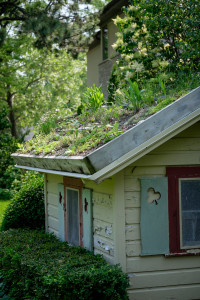
In these views you can see the roof garden, built 4 seasons ago to test techniques for building a small roofgarden on a shed or playhouse. During the last four seasons we have tested and retested plants the work in this environment, and we've identified those that flouish with little or no care.
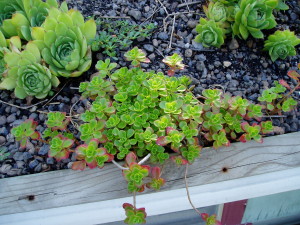
Using native plants in landscape design
/Try these!
Native plants for color and variety
A customer who has lots of coneflowers and coreopsis in his native plant garden recently asked me for a list of less common wildflowers that would add color to his summer garden, and I worked up this list: Asclepias tuberosa (shown above) -- this is the midsummer blooming orange butterfly weed that goes well with coneflowers and coreopsis
Amsonia -- there are several native versions of this plant, commonly called bluestar. Amsonia illustris or Amsonia tabernaemontana are two that come to mind. Amsonia bloom right alongside and among the coreopsis and spreads nicely among other plants.
Monarda bradburiana (above) is a beautiful and less common native beebalm if you can get it. The color of the leaves is a darker almost smoky green and it forms a nice clump.
Indian physic, Porteranthus stipulatus is a delicate plant with feathery leaves that forms a nice, airy clump among your grasses and has small starry white flowers. It's captivating among other wildflowers.
Also plant some native asters for fall color. Sky blue aster, Symphyotrychium oolentangiense is a nice, delicate blue but can spread quite annoyingly if conditions are right. New England Aster, Symphyotrychium novae-angliae or smooth blue aster Symphyotrychium laeve are also options.
What about water?
/Water is scarce and valuable in Australia. This country, the size of the U.S., is divided into only six states and its population is just under 23 million. One of the fastest growing states is New South Wales, where new homes are now required to have tanks for gray water, which is used for many purposes in the home, and not just watering the garden!
This is not news in South Australia, the "driest state in the driest inhabited continent on earth," says the website www.waterforgood.sa.gov.au
South Australia is "also feeling the added pressures of climate change, drought and a growing population." People here routinely haul water to fill tanks for gray water usage -- it's a generations-old practice, nothing new and nothing out of the ordinary. It's what you do when underground aquifers are non-existent and all water needs are met by the rivers, which in turn are dependent on rainfall to maintain a level that can supply the population with H2O!
The droughts on the past two years are the harbingers of this kind of change in the U.S. if we don't become better stewards fast.
Daily life in a dry land
/It is clear to me on this first trip to Australia that folks here are used to conservation. Even before we got here we could tell. On the airplane, most paper is placed in recycle bags by passengers. Cans and bottles are recycled separately. Once on the ground we quickly learned that ALL toilets in Australia are dual flush, and at public venues, all paper products AND utensils sold at coffee shops and take out windows are compostable. Cups are always recyclable. EVERYWHERE, even street corners, we see three bins to sort trash, recycling and composting.
Sage Advice Goes to Australia
/During the month of February, Sage Advice will be in Australia and the South Pacific. Watch this space for our travel blog -- including news about how the Aussies deal with hot dry weather!
Try this little-known native shrub
/Calycanthus
A unique shrub for shade
Calycanthus is a native shrub with an unusual waxy flower that has a fruity scent. Wonderfully different.
This one blooms before it leafs out
/Fothergilla is a spring-blooming shrub with very unusual blossoms (shown here). It grows well in both shade and sun, and is sure to get comments and compliments.
Add golden color to your shrub border
/The best way to have a garden that doesn't look like every other one on the block is to incorporate a wide variety of less-common shrubbery. Here's one to consider. Kerria is blooming now with its stunning yellow golden blossoms. And would you believe it -- this is a shade loving shrub!
A bird-friendly border
/Here’s an idea
This border is provides privacy for owners and habitat for the birds
This mid-sized suburban garden was redesigned to attract birds, using native plants and shrubs, and to provide a play area for grandchildren (foreground). The neighboring lot line house is in the background of the picture shown.
Native plants in your landscape
/Using native plants is one of the secrets of creating sustainable space because they require less care and watering. We know the shrubs, flowering plants and grasses that are native to this area. We have used them for the last 20 years, and we can help you incorporate them appropriately in your landscape design.





